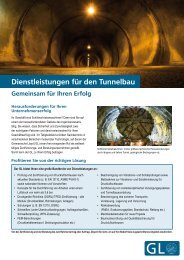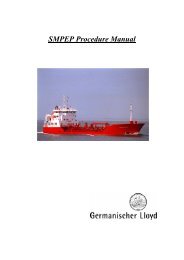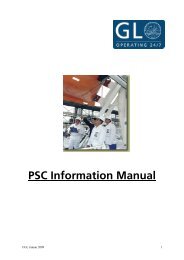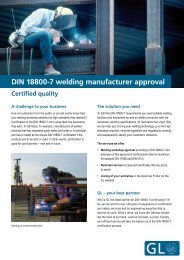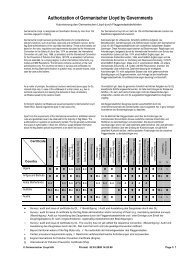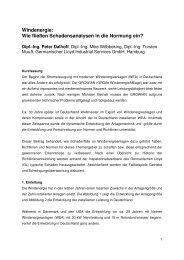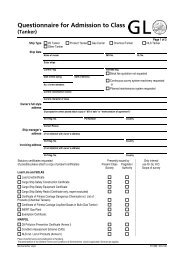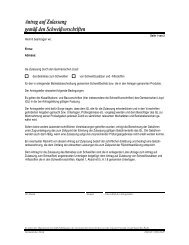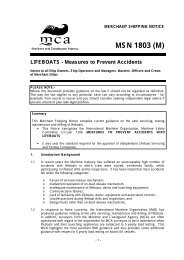ISM Risk Management - GL Group
ISM Risk Management - GL Group
ISM Risk Management - GL Group
You also want an ePaper? Increase the reach of your titles
YUMPU automatically turns print PDFs into web optimized ePapers that Google loves.
<strong>ISM</strong> <strong>Risk</strong> <strong>Management</strong><br />
Introduction<br />
Although it is not often referred to as such, the development and implementation of a documented safety<br />
management system is an exercise in risk management. The drafting or amendment of written procedures<br />
involves looking at the company’s activities and operations, identifying what could go wrong, and deciding what<br />
should be done to try to prevent it. The documented procedures are the means by which the controls are applied.<br />
The implementation of a risk assessment process in the context of ship and fleet management generally will<br />
include a definition of processes, as well as hazard identification, including a risk assessment.<br />
The underlying philosophy is to help develop an effective safety culture in companies and on board ship, where<br />
the human element is given regular and effective consideration. Its purpose is to facilitate and embed a culture of<br />
continuous improvement in safety performance without the requirement for additional regulation.<br />
A Company will need to apply the process of hazard identification and risk assessment to determine the controls<br />
that are necessary to reduce the risks of incidents. The overall purpose of the risk assessment process is to<br />
recognize and understand the hazards that might arise in the course of the organization’s activities and ensure<br />
that the risks to people arising from these hazards are assessed, prioritized and controlled to a level that is<br />
acceptable (requirements are included in different standards like <strong>ISM</strong> Code, ISO-9001:2008, ISO 14001:2004,<br />
OHSAS 18001:2007, MLC 2006 … ).<br />
The idea of operational risk assessment had always been alluded to in the <strong>ISM</strong> Code but the original language<br />
had stopped short of marking this a formal requirement of the Code. The amendments on 1st July, 2010 get<br />
much closer and do make it clear that there is an expectation that the Company will adopt a risk based approach<br />
to managing safety. Whereas the <strong>ISM</strong> Code provides in 1.2 Objectives - the requirements for risk assessment<br />
and these are distributed throughout several chapters.<br />
© Germanischer Lloyd 2010/03<br />
1.2.2. Safety management objectives of the Company should, inter alia:<br />
.2 assess all risks to its ships, personnel and the environment<br />
and establish appropriate safeguards.<br />
This includes also the basic elements of occupational health and safety, to identify any hazards, to provide<br />
measures to avoid or minimize hazards and to monitor the effectiveness of these measures.<br />
The focus of this Guideline is therefore on the application of the risk management process for assessing and<br />
improving ship operation with respect to the reduction of fatalities, damage and environmental damage.<br />
Companies holding a DOC will need appropriate procedures to fulfil the requirements of the <strong>ISM</strong>-Code.<br />
Page 1 of 11
1. General<br />
© Germanischer Lloyd 2010/03<br />
Guideline for <strong>Risk</strong> <strong>Management</strong><br />
1.1 <strong>Risk</strong> assessment and management of change<br />
Hazard identification and risk assessment methodologies vary greatly across maritime industries, ranging from<br />
simple assessments to complex quantitative analyses with extensive documentation. Individual hazards can<br />
require that different methods be used, e.g. an assessment of long term exposure to asbestos can need a<br />
different method than that taken for equipment safety or for assessing an office workstation.<br />
Each organization should choose approaches that are appropriate to its scope, nature and size, and which meet<br />
its needs in terms of detail, complexity, time, cost and availability of reliable data. In combination, the chosen<br />
approaches should result in an inclusive methodology for the ongoing evaluation of all the company’s risks.<br />
The management of change needs to be considered for changes in assessed risks, determination of controls, or<br />
the implementation of controls. <strong>Management</strong> review should be used to determine whether changes to the<br />
methodology are needed overall.<br />
To be effective, the organization’s procedures for hazard identification and risk assessment should take account<br />
of the following:<br />
- hazards,<br />
- risks,<br />
- controls,<br />
- management of change,<br />
- documentation,<br />
- ongoing review.<br />
1.2. Why use <strong>Risk</strong> Assessment<br />
<strong>Risk</strong> assessment techniques can be applied in almost all areas of maritime industries. Ship owners know that to<br />
be successful they must have a good understanding of their risks and how risks impact the people associated<br />
with their operations, their financial performance and corporate reputation.<br />
These objective values might be used in an optimisation process to<br />
- achieve a reduced level of risk with a prescribed amount of money,<br />
- reduce the costs that are required to achieve a target risk level.<br />
Furthermore, compared with traditional root cause analysis approaches, risk analysis or risk assessment is proactive.<br />
Pro-active means that hazards are identified before the un-wanted event occurs. In that sense risk<br />
analysis helps to avoid fatalities, environmental pollution and economic losses.<br />
1.3 Background to <strong>Risk</strong> Assessment<br />
Safety barriers and controls<br />
One of the fundamentals of all safety systems is the understanding of the safety barrier principle. Whenever we<br />
design safety critical systems we provide them with a certain recovery potential. We do not want that safety<br />
Page 2 of 11
© Germanischer Lloyd 2010/03<br />
Guideline for <strong>Risk</strong> <strong>Management</strong><br />
critical systems fail because of single and simple mistakes. This is why we integrate certain safety barriers and<br />
controls in our systems. If a hazard occurs it might not affect the system because of pre-installed safety barriers.<br />
These barriers do not have to be a physical protection, such as safety boots or gloves. They can also be of<br />
organisational nature etc. An overview is given below.<br />
Fig. 1.3-1: Overview about measures to safeguard safety in shipping<br />
When barriers are designed and integrated in the systems one has to pay specific attention to the nature of the<br />
target of a hazard: the ship, the cargo, the crew or other humans involved, external targets (e.g. port facilities,<br />
other ships etc.), the environment. Different hazards and targets require different barriers.<br />
Safety management is therefore a continuous process of assessment of safety barriers. The existing barriers are<br />
monitored constantly. In addition our safety critical system is monitored, too. The focus is here on missing barriers<br />
resulting from insufficient risk assessment or changes in the systems.<br />
After accidents an analysis of the function of our pre-installed safety barriers is carried out. These barriers were<br />
not always installed based on previous experience. They can also be installed based on personal judgement etc.<br />
It is therefore vital to analyse if the safety barriers in each system have the right dimensions. Accidents,<br />
unfortunately, are practical tests for our barriers. If they did not function, we have to improve them.<br />
2. Introduction to the <strong>Risk</strong> Assessment Process<br />
Before we install safety barriers we assess our systems. <strong>Risk</strong> management is a complex process. It consists of<br />
the following phases:<br />
• <strong>Risk</strong> analysis and estimation<br />
• <strong>Risk</strong> assessment<br />
• <strong>Risk</strong> management and control<br />
Page 3 of 11
© Germanischer Lloyd 2010/03<br />
Guideline for <strong>Risk</strong> <strong>Management</strong><br />
During the analysis the vital components of technical/operational systems and potential hazards endangering the<br />
functionality of these systems are identified.<br />
The next step is concerned with the estimation of frequencies of the appearance of these hazards and the<br />
resulting consequences. During risk assessment suitable <strong>Risk</strong> Control Options (RCOs) are identified, evaluated,<br />
and the most appropriate <strong>Risk</strong> Control Measure (RCM) selected. The selected RCMs are the barriers that should<br />
prevent a hazard from hampering the vital components in our technical/operational systems.<br />
<strong>ISM</strong> requires proactive and reactive measures. Element 10 “Maintenance of the ship and equipment” requires the<br />
identification of critical equipment and systems (10.3). This is a proactive measure. A similar requirement is the<br />
risk assessment for routine planned maintenance of critical equipment before the equipment is shut down. During<br />
these considerations safety barriers will be integrated in the systems intended to mitigate accidents. During<br />
accident investigation (Element 9) the functionality of these safety barriers will be analysed and the barriers have<br />
to be adapted where required.<br />
Acceptance<br />
criteria<br />
<strong>Risk</strong> assessment<br />
<strong>Risk</strong> analysis<br />
<strong>Risk</strong> management and risk control<br />
Frequency<br />
analysis<br />
<strong>Risk</strong> estimation<br />
Analysis<br />
preparation<br />
System<br />
definition<br />
Hazard<br />
identification<br />
<strong>Risk</strong><br />
matrix<br />
<strong>Risk</strong><br />
evaluation<br />
<strong>Risk</strong> Acceptable<br />
or ALARP<br />
Consequence<br />
analysis<br />
Fig. 2-1: <strong>Risk</strong> management process<br />
<strong>Risk</strong><br />
reduction<br />
Page 4 of 11
© Germanischer Lloyd 2010/03<br />
Guideline for <strong>Risk</strong> <strong>Management</strong><br />
<strong>Risk</strong> analysis - is a decision-making aid (How safe?). It can be of great help in considering alternatives, but it<br />
fails if it is not known which questions have to be answered. The main advantage of a risk analysis is that it<br />
provides a structured access or identification to the hazards combined with a system or a process and thus<br />
providing a decreasing quantity of not realised hazards.<br />
<strong>Risk</strong> analysis is followed by the <strong>Risk</strong> Assessment (How safe is safe enough?). The main task of the risk<br />
assessment is the risk evaluation, i.e. to decide if the estimated risk is acceptable. The usual procedure in risk<br />
calculation involves addition or multiplication of the parameters “frequency” and “severity’’. The (qualitative)<br />
results are then presented in a risk matrix. The evaluation requires an acceptance criterion.<br />
<strong>Risk</strong> management and control (How to achieve an adequate level of safety?) <strong>Risk</strong> management as the<br />
whole process, which includes the risk evaluation - the judgement whether a risk is acceptable or not. <strong>Risk</strong><br />
management is the process whereby decisions are made to accept a known or assessed risk and/or the<br />
implementation of action to reduce the consequences or probability of occurrence.<br />
The hazard identification and risk evaluation are key elements of the risk assessment. In this context the terms<br />
acceptable and unacceptable risk are important. Between these two regions the ALARP (As Low As Reasonable<br />
Practicable) region is defended. In order to demonstrate that a specific risk is ALARP so–called risk control<br />
measures are analysed. <strong>Risk</strong> control measures are introduced to reduce the risk to an acceptable level<br />
2.1 Methods of Hazard Identification and <strong>Risk</strong> Assessment<br />
In Figure 2.1-1 an overview and a classification of the different methods for hazard identification and risk<br />
assessment are shown.<br />
Figure 2.1-1: Overview of risk assessment methods<br />
Page 5 of 11
© Germanischer Lloyd 2010/03<br />
Guideline for <strong>Risk</strong> <strong>Management</strong><br />
The “typical methods” are to be understood as practical risk assessment instruments. In general, the methods<br />
are based on checklists and primarily permit qualitative risk identification. They are commonly applied in practice<br />
for applications in diverse sectors. It should be noted that, while the designations and implementation of individual<br />
methods may vary, the fundamental principles remain unchanged.<br />
The hazard identification may be performed, dealing with the question “What can go wrong?” Hazard or Danger is<br />
posed by a situation in which there is an actual or potential threat for the crew, the ship or the environment.<br />
For any practical approach, the identification of hazards is the first and most important step in risk estimation.<br />
The question “when is the risk small enough to be ignored?” can really only be answered by your conscience.<br />
Nonetheless, a distinction must be made between unknown risks and those which are accepted for reasons of<br />
expense. Due to the pressure of cost and time, many unknown risks remain unspecified.<br />
Incidents and accidents are reality. Incident investigations provide important information of significant risk<br />
contributors. Appropriate methods are include<br />
- Analysis (statistical) of historical data<br />
- Root-cause-analysis.<br />
A simple example using a few of these terms regarding risks associated with an electrical power supply line:<br />
Hazard >> High voltage<br />
Incident >> Wire gets exposed<br />
Accident >> Personal contact resulting in shock<br />
2.2 <strong>Risk</strong> Assessment in practice<br />
Consequence >> Burns / electrocution<br />
<strong>Risk</strong> Assessment and control is a continual process. Hence, written risk assessments should be subject to<br />
periodic formal reviews to confirm the validity of the assessment and whether the risk controls are still effective<br />
and adequate (e.g. relating to type of ship, the nature of operations and the type and extent of the hazards and<br />
risks).<br />
The focus of this risk assessment is on the<br />
• implications to the existing system<br />
• interrelation to other changes and development<br />
Assuming that a complete risk assessment exists we re-assess<br />
• how the likelihood is affected<br />
• how the consequences change<br />
• how existing barriers are affected<br />
Otherwise, a complete risk assessment has to be conducted.<br />
Page 6 of 11
© Germanischer Lloyd 2010/03<br />
Guideline for <strong>Risk</strong> <strong>Management</strong><br />
This risk assessment should follow the guidance given in ANNEX-A in the step-by step guideline, i.e. by<br />
conducting these steps:<br />
1. Classify work activities<br />
2. Identification of hazards (based on work activities)<br />
3. Identification of existing RCMs (controls in place)<br />
4. Estimate <strong>Risk</strong> (severity and frequency of harm, risk factor)<br />
5. <strong>Risk</strong> acceptable?<br />
6. <strong>Risk</strong> control action plan (action to be taken following the assessment)<br />
7. Review adequacy of action plan<br />
8. Ensure risk assessment and risk control measures are effective and up-to-date<br />
When identification of hazards it should be taken into account that the change measures might affect existing<br />
safety barriers.<br />
What should be assessed?<br />
The assessment should cover the risks arising from the work activities on the ship. The assessment is not<br />
expected to cover risks which are not reasonably foreseeable.<br />
Employers are advised to record the significant findings of their risk assessment. <strong>Risk</strong>s which are found to be<br />
trivial, and where no further precautions are required, need not be recorded.<br />
The process of risk assessment should be carried out by suitably experienced personnel, using specialist advice<br />
if appropriate. <strong>Risk</strong> assessment should be seen as a continuous process. In practice, the risks in the workplace<br />
should be assessed before work begins on any task for which no valid risk assessment exists.<br />
This risk assessment has to be documented; the form or checklist for risk assessment may be used and has to be<br />
filed. The risk mitigation measures resulting from the risk assessment have to be taken up in the records.<br />
The tables below are shown in the form of risk matrix in which they most commonly appear, but they are not<br />
mandatory. The risk matrix may be expanded or reduced rows and columns, depending on how finely the<br />
company wishes to distinguish the categories. The terms used for frequency (likelihood) and consequence<br />
(severity) may be changed to assist understanding.<br />
For example, frequency (likelihood) may be expressed in terms of “once per trip”, “once per ship year” or “once<br />
per fleet year”, and consequence may be made more specific by the use of “first aid injury”, “serious injury” or<br />
“death”, not forgetting the consequences for property and the environment.<br />
<strong>Risk</strong> - the combination of the frequency and severity of the consequence.<br />
RISK = FREQUENCY X CONSEQUENCE<br />
Frequency - The number of occurrences per time unit (e.g. “per year” or “once per trip” or “once per ship year”…)<br />
Consequence - The outcome of an accident (quantified by some measure of severity)<br />
In other words, risk has two components: likelihood of occurrence and severity of the consequences. And thus<br />
risk is always expressed with a time dependent dimension.<br />
The risk matrix (table 1) shows a simple method for estimating risks according to the potential severity of and the<br />
likelihood, as described above.<br />
The next step is to decide which risks are acceptable, tolerable or unacceptable. In making decisions as to<br />
whether the risk is tolerable the work force should be consulted.<br />
Page 7 of 11
© Germanischer Lloyd 2010/03<br />
Guideline for <strong>Risk</strong> <strong>Management</strong><br />
Having determined the significant risks, the next step is to decide what action should be taken to improve safety,<br />
taking account of precautions and controls already in place.<br />
The outcome of a risk assessment should be an inventory of actions. Any action plan should be reviewed before<br />
implementation, if the revised controls lead to tolerable risk level.<br />
<strong>Risk</strong> Assessment and control is a continual process. Hence, written risk assessments should be subject to<br />
periodic formal reviews to confirm the validity of the assessment and whether the risk controls are still effective<br />
and adequate.<br />
Table 1 <strong>Risk</strong> matrix for determination of the <strong>Risk</strong> Priority Number (RPN)<br />
Consequence<br />
Severity<br />
catastrophic<br />
4<br />
3<br />
severe<br />
significant<br />
2<br />
1<br />
minor<br />
medium<br />
medium-low<br />
low<br />
<strong>Risk</strong> Matrix<br />
high-medium<br />
medium<br />
medium-low<br />
high-medium high<br />
high-medium high-medium<br />
medium<br />
Note: Low risk here means that the risk has been reduced to the lowest level that is reasonably practicable<br />
<strong>Risk</strong> Level Acceptable<br />
low<br />
extremely<br />
remote<br />
1<br />
Occurrence frequency<br />
remote<br />
2<br />
low<br />
<strong>Risk</strong> Level Tolerable<br />
(Existing risk control measures<br />
to be reviewed to ensure ALARP level)<br />
Page 8 of 11<br />
high-medium<br />
medium-low medium<br />
reasonably<br />
probable<br />
3<br />
frequent<br />
<strong>Risk</strong> Level is not Tolerable<br />
(RCMs to be modified and/or additional risk<br />
control measures to be implemented)<br />
4
Table 2 Rating Scale – severity<br />
© Germanischer Lloyd 2010/03<br />
Guideline for <strong>Risk</strong> <strong>Management</strong><br />
SI Severity Effects on human safety Effects on ship Effects on environment<br />
1 Minor Single or minor injuries Local equipment /<br />
structural damage<br />
2 Significant Multiple or severe injuries Non-severe ship<br />
damage<br />
3 Severe Single fatality or multiple<br />
severe injuries<br />
Non-significant spill up to a<br />
few barrels of pollution to<br />
sea<br />
A few tonnes of pollution to<br />
sea. Situation is manageable<br />
Severe damage Significant pollution<br />
demanding urgent measures<br />
for the control of the situation<br />
and/or the cleaning of<br />
affected areas<br />
4 Catastrophic Multiple fatalities Total loss Major pollution with difficult<br />
control of situation and/or<br />
difficult cleaning to affected<br />
areas<br />
Table 3 Rating scale – frequency occurrence (IACS)<br />
FI Frequency Definition<br />
4 Frequent Likely to occur once per month on one ship<br />
3 Reasonably probable Likely to occur once per year in a fleet of 10 ships, a few<br />
times in a ship life<br />
2 Remote Likely to occur once per year in a fleet of 1000 ships,<br />
once in the total life of several similar ships<br />
1 Extremely remote Likely to occur once in 10 years in a fleet of 10000 ships<br />
Page 9 of 11
3. Change <strong>Management</strong> and Control<br />
© Germanischer Lloyd 2010/03<br />
Guideline for <strong>Risk</strong> <strong>Management</strong><br />
It is recommended that the Company should manage and control any changes that can affect or impact its<br />
hazards and risks. This includes changes to the organization’s structure, personnel, management system,<br />
processes, activities, use of materials, etc. Such changes should be evaluated through hazard identification and<br />
risk assessment prior to their introduction.<br />
The Company should consider hazards and potential risks associated with new processes or operations at the<br />
design stage as well as changes in the organization, existing operations, products, services or suppliers.<br />
The following are examples of conditions that should initiate a management of change process:<br />
- new or modified technology (including software), equipment, facilities, or work environment,<br />
- new or revised procedures, work practices, designs, specifications or standards,<br />
- different types or grades of materials, cargo etc.<br />
- significant changes to the site’s organizational structure and staffing, including the use of contractors,<br />
- modifications of health and safety devices and equipment or controls.<br />
3.1 Determining the need for controls<br />
Having completed a risk assessment and having taken account of existing controls, the organization should be<br />
able to determine whether existing controls are adequate or need improving, or if new controls are required.<br />
If new or improved controls are required, their selection should be determined by the principle of the hierarchy of<br />
controls, i.e. the elimination of hazards where practicable, followed in turn by risk reduction (either by reducing the<br />
likelihood of occurrence or potential severity of injury or harm), with the adoption of personal protective equipment<br />
(PPE) as a last resort.<br />
The following provides examples of implementing the hierarchy of controls:<br />
- Elimination – modify a design to eliminate the hazard, e.g. introduce mechanical lifting devices to<br />
eliminate the manual handling hazard;<br />
- Substitution – substitute a less hazardous material or reduce the system energy (e.g. lower the force,<br />
amperage, pressure, temperature, etc.);<br />
- Engineering controls – install ventilation systems, machine guarding, interlocks, sound enclosures, etc.;<br />
- Signage, warnings, and/or administrative controls – safety signs, hazardous area marking, photo<br />
luminescent signs, markings for pedestrian walkways, warning sirens/lights, alarms, safety<br />
- procedures, equipment inspections, access controls, safe systems of working, tagging and work permits,<br />
etc.;<br />
- Personal protective equipment (PPE) – safety glasses, hearing protection, face shields, safety<br />
harnesses and lanyards, respirators and gloves.<br />
In applying the hierarchy consideration should be given to the relative costs, risk reduction benefits, and reliability<br />
of the available options.<br />
3. 2 Recording and documenting the results of changes<br />
The process for such change management shall be documented in a formal documented procedure. <strong>Risk</strong><br />
assessment is a part of the change process and therefore has to be documented, too.<br />
Page 10 of 11
© Germanischer Lloyd 2010/03<br />
Guideline for <strong>Risk</strong> <strong>Management</strong><br />
As a consequence of this, the verification of the change management process must be part of the <strong>ISM</strong><br />
certification (during document verification, office audit and shipboard audits).<br />
The organization should document and keep the results of hazard identification, risk assessments and<br />
determined controls. The following types of information should be recorded:<br />
- identification of hazards,<br />
- determination of the risks associated with the identified hazards,<br />
- indication of the levels of the risks related to the hazards,<br />
- description of, or reference to, the measures to be taken to<br />
- control the risks,<br />
- determination of the competency requirements for implementing<br />
- the controls .<br />
When existing or intended controls are used in determining risks, these measures should be clearly documented<br />
so that the basis of the assessment will be clear when it is reviewed at a later date.<br />
The description of measures to monitor and control risks can be included within operational control procedures.<br />
The determination of competency requirements can be included within training procedures.<br />
In order to control all documents and to trace the history, it is necessary to file all of the previous releases of the<br />
data on a separate medium or computer. It has to be made sure that these obsolete data are not considered as<br />
being current, by error.<br />
4. Ongoing review<br />
It is a requirement that hazard identification and risk assessment be ongoing. This requires the company to<br />
consider the timing and frequency of such reviews.<br />
Periodic reviews can help ensure consistency across risk assessments carried out by different people at different<br />
times. Where conditions have changed and/or better risk management technologies have become available,<br />
improvements should be made as necessary.<br />
It is not necessary to perform new risk assessments when a review can show that the existing or planned<br />
controls remain valid.<br />
For further information please contact:<br />
Germanischer Lloyd AG<br />
Systems Certification <strong>ISM</strong>/ISPS/ISO<br />
HUB Germany<br />
Brooktorkai 18<br />
20457 Hamburg / Germany<br />
Phone: +49 (0) 40-36149-7013<br />
Fax: +49 (0) 40-36149-1702<br />
e-mail: ism@gl-group.com<br />
Page 11 of 11
ANNEX – A<br />
© Germanischer Lloyd 2010<br />
ANNEX - <strong>Risk</strong> <strong>Management</strong><br />
<strong>Risk</strong> guide - a practical step by step approach to risk and change management<br />
Step 1 - Classify work activities<br />
Investigation about hazards, key process, detailed task, subtask<br />
Step 2 - Identify hazards for the work activity.<br />
Consider different scenarios under different conditions e.g. new crew, darkness, stormy<br />
weather, rain. Development of hazard prompt list for your operation activities including<br />
equipment and machinery which is used; shipboard hazards to personnel, hazards to the vessel<br />
hazardous, substances used on board; physical, chemical, biological hazards or psychosocial<br />
hazards, other have to be observed… .<br />
Step 3 - Identify risk controls<br />
safeguards against risk, safe working practices, procedures and instruction,<br />
familiarization, use of PPE<br />
Step 4 - Determine risk. Assess likelihood and potential consequences of the scenarios.<br />
determine the potential severity of harm and the likelihood that harm will occur, apply the IACS rating<br />
scale for severity, scale for frequency to decide on likelihood …<br />
Step 5 - Decide if risk is tolerable<br />
calculate the <strong>Risk</strong> Priority Number-RPN by use of risk matrix, evaluate the risk and decide on<br />
further action …<br />
Step 6 - Prepare a risk control action plan to improve risk controls as necessary<br />
Develop additional <strong>Risk</strong> Control Options-RCO, list measures to implement changes, ensure<br />
that risk is reduced to ALARP [As Low As Reasonable Practicable] level.<br />
Step 7 - Review adequacy of action plan, confirm whether risk are now acceptable or tolerable<br />
Investigate the effect of the additional <strong>Risk</strong> Control Measures-RCM, compare the benefits with<br />
time and efforts.<br />
Step 8 - Ensure risk assessments and risk control measures are effective and up to date<br />
Monitor implementation, review change, regular review the adequacy and effectiveness of the<br />
risk controls<br />
Page 1 of 4
ANNEX - B<br />
© Germanischer Lloyd 2010<br />
ANNEX - <strong>Risk</strong> <strong>Management</strong><br />
Hazard Prompt List (Example)<br />
The Hazard Prompt List may help with the identification of hazards for work activities. The list is not exhaustive<br />
but conversely companies will not encounter all the hazards shown below. The list should be updated as soon as<br />
hazards have been identified which are not on the list.<br />
1. List of hazards for ship operation<br />
1.1 Human-related hazards<br />
.1 Personal factors<br />
- reduced ability, e.g. reduced vision or hearing<br />
- lack of motivation, e.g. because of a lack of incentives to perform well<br />
- lack of ability, e.g. lack of seamanship, unfamiliarity with vessel, lack of fluency of the language<br />
used onboard<br />
- fatigue, e.g. because of lack of sleep or rest, irregular meals<br />
- stress<br />
.2 Organizational and leadership factors<br />
.3 Task features<br />
- Inadequate vessel management, e.g. inadequate supervision of work, lack of coordination of work,<br />
lack of leadership<br />
- Inadequate ship owner management, e.g. inadequate routines and procedures, lack of resources<br />
for maintenance, lack of resources for safe operation, inadequate follow-up of vessel organization<br />
- Inadequate manning, e.g. too few crew, untrained crew<br />
- Inadequate routines, e.g. for navigation, engine room operations, cargo handling, maintenance,<br />
emergency preparedness<br />
- task complexity and task load, i.e. too high to be done comfortably or too low causing boredom<br />
- unfamiliarity of the task<br />
- ambiguity of the task goal<br />
- different tasks competing for attention<br />
.4 Onboard working conditions<br />
- physical stress from, e.g. noise, vibration, sea motion, climate, temperature, toxic substances,<br />
extreme environmental loads, night-watch<br />
- ergonomic conditions, e.g. inadequate tools, inadequate illumination, inadequate or ambiguous<br />
information, badly-designed human-machine interface<br />
- social climate, e.g. inadequate communication, lack of co-operation<br />
- environmental conditions, e.g. restricted visibility, high traffic density, restricted fairway<br />
Page 2 of 4
© Germanischer Lloyd 2010<br />
ANNEX - <strong>Risk</strong> <strong>Management</strong><br />
1.2 Shipboard hazards to personnel<br />
- inhalation of harmful substances (e.g.toxic gases)<br />
- burns from substances like acids<br />
- electric shock<br />
- person falls from height or slips<br />
- person falls overboard<br />
- other injuries, etc.<br />
1.3 Hazards to the vessel<br />
.1 Loss Of Watertight Integrity (LOWI)<br />
- contact or collision<br />
- explosion<br />
- fire<br />
- flooding<br />
- grounding or stranding<br />
- loss of hull integrity, structural failure<br />
.2 Hazards external to the ship<br />
- storms<br />
- lightning<br />
- uncharted submerged objects<br />
- other ships<br />
- attacks (pirates, terrorists)<br />
- war<br />
1.4 Hazardous substances on board ship<br />
.1 Accommodation areas<br />
- combustible furnishings<br />
- cleaning materials in stores<br />
- oil/fat in galley equipment<br />
.2 Deck Areas<br />
- cargo<br />
- paint, oils, greases etc. in deck stores<br />
.3 Machinery spaces<br />
- cabling<br />
- fuel and diesel oil for engines, boilers and incinerators<br />
- fuel, lubricating and hydraulic oil in bilges, save ails, etc.<br />
- residual oils<br />
- refrigerants<br />
- thermal heating fluid systems<br />
Page 3 of 4
1.5 Potential sources of ignition<br />
.1 General<br />
- electrical arc<br />
- friction<br />
- hot surface<br />
- incendiary spark<br />
- naked flame<br />
- radio waves<br />
.2 Deck areas:<br />
- deck lighting<br />
- funnel exhaust emissions<br />
- hot work sparking<br />
.3 Machinery spaces:<br />
- air compressor units<br />
- engine exhaust manifold<br />
© Germanischer Lloyd 2010<br />
ANNEX - <strong>Risk</strong> <strong>Management</strong><br />
2. Additional hazards for cargo operation<br />
2.1 Hazards of cargo<br />
- flammability<br />
- toxity<br />
- density<br />
- Corrosion<br />
- …<br />
2.2 Operational Hazards<br />
- pollution<br />
- static electricity<br />
- smoking<br />
- naked lights<br />
- use of electrical equipment<br />
- use of tools<br />
- use of communication equipment<br />
- spontaneous combustion<br />
- enclosed spaces<br />
- etc.<br />
Source: ISGOTT, IMO FSA MSC/Circ. 1023<br />
Page 4 of 4





